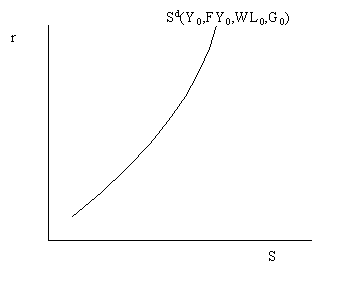
Reading: AB, chapter 4, section 1.
Aggregate demand, the desired amount of aggregate expenditure, can be discussed in terms of desired consumption expenditure, Cd, and desired investment, Id, or in terms of desired national saving, Sd, and desired investment. The reason is that we define desired national saving as: Sd = Y - Cd - G0.
By definition, saving is what is left over from current income after we have decided how much to consume. Decisions about consumption and saving involve decision about how much to consume today and how much to consume in the future. After all, the reason we save is so that we have wealth in the future, when we are no longer working, so that we can maintain consumption. Accordingly, any reasonable model for consumption and saving must take into consideration factors that influence our consumption today and our consumption in the future. Our model for national saving (private saving plus public saving) is of the form:

where
r = real interest rate
Y = real GDP (income)
FYe = expected future income
WL = wealth
G = government spending.
Increases in the real interest rate affect desired saving in two different ways:
The relationship between desired national saving and the real interest holding fixed Y, FYe, WL and G is called the savings curve and is illustrated below:

The savings curve is steep because the substitution effect is empirically very weak: it takes a very
large increase in the real interest rate to induce individuals to save more. The savings curve shifts
out and to the right (savings increases) when either Y, FYe or WL increases. Conversely, the
savings curve shifts up and left (savings decreases) whenever G increases.
[Next Slide] [Previous Slide] [Slides from Lectures] [301 Homepage]
Last Updated July 18, 1996 by Eric Zivot